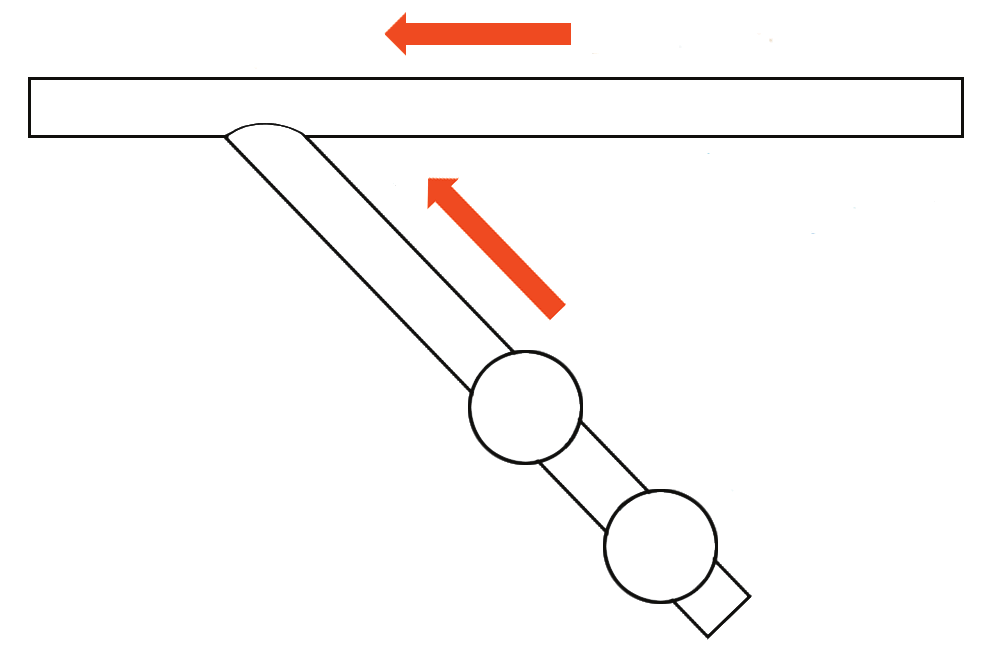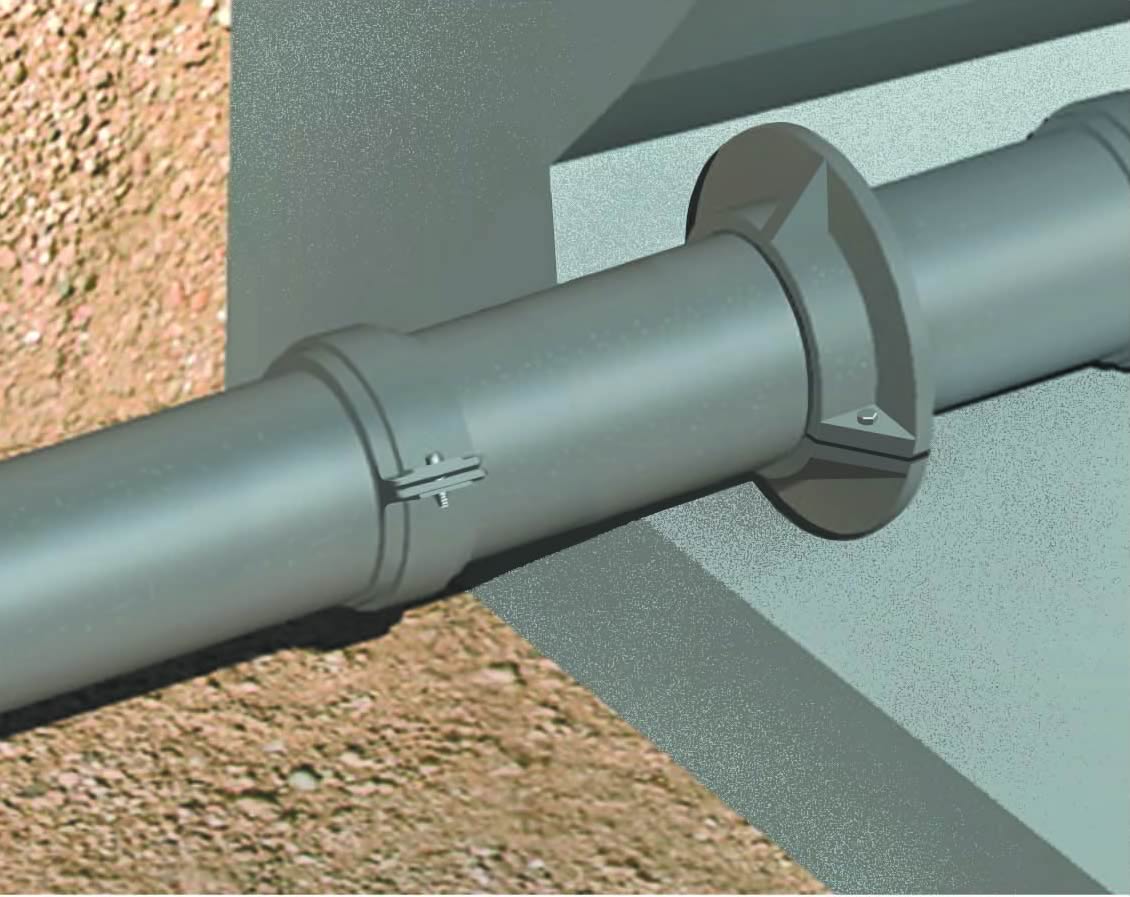INSTALLATION BELOW GROUND
Buried Pipelines
While both pipe systems use the same 2-pack Epoxy coating, the coating used on the Halifax Drain system is thicker than that used on the Halifax Soil system and as such, has a higher resistance to chemical attack. This makes the Halifax Drain system more suited to being buried in the ground. It should be noted however that where the products are to be placed in particularly aggressive soils (e.g. peat) where the PH value is less than 6, it is recommended that the pipe system be encased in polyethylene sleeves for additional protection.
Trench Preparation
Halifax drainage may be laid directly into an accurately trimmed trench allowing 50mm clearance beneath each coupling joint. The bottom of the trench should be flat to provide continuous support. Where accurate trimming cannot be achieved due to the subsoil condition, it will be necessary to excavate an additional 100mm to allow a granular bed to be laid whilst still maintaining the 50mm clearance beneath each joint.
Concrete Encasement
In a situation where the pipes need to be encased in concrete, provided the applied coating is dense, undamaged and free from bare patches and lack of adhesion, they will form a barrier between the cast iron and the concrete therefore making either system suitable for use. However, due to the thicker coating mentioned above, If we were to recommend a product system to be completely encased in concrete (as opposed to a short length passing through a concrete wall/foundation), the Halifax Drain system would be the most appropriate. In the event that the concrete encasement becomes damaged or is not fully coherent, the painted surface of the casting may be required to form a barrier between the otherwise exposed cast iron and any encroaching aggressive substances.
Bedding in concrete
When a concrete bed is required prepare the trench as above to provide 100mm of concrete under the pipe but support the pipe on a compressible material (expanded polystyrene) either side of each joint. If the pipework is being surrounded in concrete provision should be made for a flexible joint, within the concrete, at 5m intervals and placed next to a pipe joint. This should be made of suitable compressible material and cover the full cross sectional area of the concrete. It is recommended that inspection and testing of the pipework is completed in sections prior to haunching and surround with concrete.
Settlement
Pipework leaving buildings and manholes which may be subject to settlement should incorporate a minimum of two joints close to the point of exit at a maximum of 600mm apart. This will provide a short length of pipe to act as a “rocker pipe” and in areas where large settlement is expected more than one may be required.
Under the provisions of BS EN 877, the couplings within the system are designed to function with up to 3˚ of deflection. It is this allowance along with the short pipe length which permits the movement due to settlement without impeding the function of the pipe system.

Depth of Pipework
Halifax drainage may be installed under most buildings without additional protection, but when laid under roads with less than 1.2m cover and in areas which are subject to special loadings it is recommended that extra protection be considered.
Pipe Falls
The pipework gradient should provide a self-cleaning action under normal discharge conditions. For flows of less than 1 litre/sec. gradients of 1 in 40 for 100mm pipe and 1 in 60 for 150mm pipe are usually satisfactory; but in any case the gradients should not be less than 1 in 80 for 100mm pipe and 1 in 150 for 150mm pipe.
Provision for Access
Access is required on drainage pipelines to enable the rodding and clearing of any debris and may be provided by manholes, chambers, access fittings or rodding eyes/roddable gullies – the latter allowing downstream access only.
As a general guide, no part of a drain should be further from a manhole than 45 metres and the distance between manholes should not exceed 90 metres. Where one drain connects with another drain without provision of access in the form of a manhole or inspection chamber, access should be provided on the branch drain within 12 metres of the junction. Where the drainage pipeline changes direction either vertically or horizontally; it is recommended an access fitting be incorporated in the design.

Puddle Flanges
In basement areas where pipes pass through external walls it may be necessary to install a puddle flange. For locations which are below the water table or in areas liable to flooding, puddle flanges will reduce the risk of water entering the building.
Denso tape or similar should be wrapped around the pipe before bolting on the two piece puddle flange; this will ensure a water tight seal is achieved.
When pipes are installed through pipe sleeves which have been cast into the concrete wall section, it will be necessary to seal the gap between the sleeve and pipe passing through it with a mastic/ sealant.

Cutting Pipes
Halifax Soil & Drain pipes are easy to cut when shorter lengths are required. We recommend the use of a powered chop saw or disc cutter with the appropriate metal cutting disc fitted (a manual hacksaw is not practical!).
Any burrs or sharp edges should be removed prior to installation to avoid damage to the gaskets. Please see note below regarding paint touch-up.
Caution: – Ensure that eye, respiratory and hand protection are worn at all times when cutting pipes. If power tools are to be used, ensure the area is free from flammable materials/chemicals which may ignite from sparks.
Touching-Up
Any areas of exposed metal (including cut ends of pipes) should be touched up prior to installation. First any dust, debris or loose paint should be removed then the area should be lightly sanded to ensure good adhesion of paint. The area should then be touched up using a high-quality paint suitable for outdoor use on metallic surfaces.




